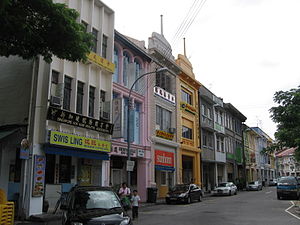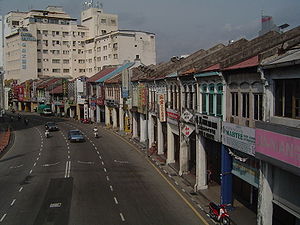- Shophouse
-
A shophouse is a vernacular architectural building type that is commonly seen in areas such as urban Southeast Asia. This hybrid building form characterises the historical centres of most towns and cities in the region.
Contents
Design and features
Shophouses may nominally stretch as high as three floors in densely populated locations. Depicted here is a row of mid 20th century, three storey shophouses in Chinatown, Singapore of traditional, Art Deco and International styles.
Multi-functional
Typically, shophouses consist of shops on the ground floor which open up to a public arcade or "five-foot way", and which have residential accommodation upstairs. The shophouses would abut each other to form rows with regular facade, fire walls and adherence to street alignment.
As its name suggests, a shophouse often contains a shop with separate residential spaces. More generally, space occupied by the former contains a semi-public function. While this usually is, and historically usually was, a shop, it could just as easily be a food and beverage outlet (e.g. coffeeshop or bar), a service provider (e.g. clinic or barber), an industrial activity (e.g. cottage industry or auto workshop) or a community space (e.g. a school or clan association). Residential spaces are meant to accommodate one or more families, or serve as a dormitory for single workers. Popular belief holds that shophouses were initially occupied by single families, with their private living areas in one space and the more public family business in another. However, it is possible that the two spaces were always usually used by unrelated persons or groups, who may be tenants or resident owners. The position of the shop and residential space depends on the number of floors of the shophouse: A single storey shophouse tends to include residential space behind the shop, while residential spaces in shophouses of two or more storeys are typically located above the shop.
Low rise
A terraced layout allows a row of shophouses to extend as long as a city block permits, as exemplified by this long row of double storey shophouses in George Town, Penang.
Shophouses are generally low rise buildings. They have a minimum of one floor, but shophouses with two storeys are abundant, while three storey shophouses are typically present in more prosperous and densely built up central areas. However, shophouses of five or more storeys are not unknown, and are more common among newer counterparts. Heights were constrained by building technology and levels of prosperity.
Narrow fronts, deep rears
Shophouses have narrow street frontages, but may extend backwards to great depths, in some cases extending all the way to the rear street. A number of reasons have been given for the narrow widths of these buildings. One reason relates to taxes, i.e. the idea that buildings were historically taxed according to street frontage rather than total area, thereby creating an economic motivation to build narrow and deeply. Another reason is building technology: the timber beams that carried the roof and floor loads of these structures were supported by masonry party walls. The extent of frontage was therefore affected by the structural span of the timber used. While all shophouses appear, visually, to have similarly narrow widths, these are not uniform and minor variations are the rule, especially when comparing buildings built at different times, by different owners and with different materials or technologies.
Terraced building
Shophouses are urban terraced buildings, i.e. standing right next to each other along a street, with no gap or space in between buildings (in similar vein as a terraced house). Frequently, a single wall separates the shophouses on either side of it.
"Five-foot ways"
 An example of a five-foot way along a row of shophouses in Selangor, Malaysia.
An example of a five-foot way along a row of shophouses in Selangor, Malaysia.
The covered walkway along the road is within the shophouse property line but is for public use, providing pedestrians shade from sun and rain. This practice can be traced to antecedents in South China, but also to the Royal Ordinances by Phillip II of 1573. In early Manila two storey houses were built in rows with arcades on the ground floor.[1] A key development was the Raffles Ordinances (1822) for Singapore which stipulated that “all houses constructed of brick or tiles have a common type of front each having an arcade of a certain depth, open to all sides as a continuous and open passage on each side of the street”. This practice spread to other States in British Malaya and by-laws with requirements for “verandah-ways of...at least seven feet measuring from the boundary of the road .....and the footway within any verandah-way must be at least five feet in the clear.”[2]
The by-laws were an important element in the evolution of the shophouse building form. They were not easy to implement: builders naturally wanted to build on and use as much of their land as possible. Even to this day municipal authorities have to occasionally make sure that the arcades are kept free from shopkeepers blocking the path with their goods.
In other parts of Southeast Asia, shophouses lack this distinctive and, if the by-laws are observed, useful feature that protects pedestrians from the sun and frequent torrential rain. Older shophouses in Bangkok, for example, may have a plain ledge without gutters jutting out over the pavement, while newer ones may do without this element altogether.
Internal courtyards
One of the most important features of the shophouse is the use of a variety of open-to-sky spaces to admit natural daylight as well as natural air. These open-to-sky spaces may be back yards, small airwells and most commonly, internal courtyards. Depending on their size, these courtyards may be landscaped spaces for quiet reflection, places to dry laundry, vents for cooking fumes or toilet odours or spaces for any number of household activities.
Party walls
The party walls that separate most shophouses from their neighbours are generally constructed out of masonry (usually locally manufactured baked clay bricks) and they are structural, load-bearing walls, i.e. they transfer the weight of the roof and upper floors down to the ground. Party walls marked a major shift from traditional timber post-and-beam frame construction of pre-colonial Southeast Asia. Masonry was used to bear the heavy loads, to provide privacy and security and, importantly, to serve as a barrier to the spread of fire in a crowded urban settlement. Modern shophouses use similar materials but additionally include reinforced concrete beams.
Roofs
Shophouses are roofed using orange clay roof tiles. Again, this marks an important shift away from the use of more organic coconut frond thatch (called 'attap') in traditional architecture. The added cost of clay tiles was borne due to their greater durability and especially their resistance to fire.
Floors and beams
Traditionally shophouses were built with structural (i.e. load bearing) timber beams which carried the weight of the roof and floors. Floor were similarly made of timber planks, often with narrow gaps in between them to allow air to filter through and to help the building (and its inhabitants) to 'breathe' better. The use of timber beams and floor boards was very much in line with local building traditions. Modern shophouses, on the other hand, use reinforced concrete beams and slabs.
Facade colours
Tourists often enjoy visiting and walking around shophouse districts because of the variety of colours used in their facade decoration. Traditionally, many shophouses would have been plastered an off-white colour. Other popular early colours were indigo and ochre, given the range of available pigments. By the mid-20th century, pastel colours (rose pink, baby blue, light yellow, etc.) became popular, and they remain the colours that most people most strongly associate with these buildings. However, many contemporary or restored shophouses have now taken to using very bold colours, including deep reds, black, silver, gold, purple, etc.
Facade ornamentation
Traditional shophouse facade ornamentation draws inspiration from the Malay, Chinese and European traditions. European neo-classical motiffs include egg-and-dart mouldings and ionic or corinthian capitals on decorative pillasters. From the Malay building tradition, elaborate woodwork has been borrowed in the form of carved panels. fascia boards, louvres, screens and fretwork. Finally, from the Chinese tradition comes mythological motifs like phoenixes. Other traditions include the use of Peranakan pastel coloured glazed tiles, often with floral or geometric motifs.
In comparison to traditional shophouses, modern variations through the 1950s up until the 1980s were devoid of ornamental decorations and are more often designed for utilitarian purposes. Beginning the 1990s, the buildings began to adopt postmodern and revival styles.
History and use
This building type evolved from the late 18th century during the colonial era. After the colonial era, shophouses became old and dilapidated, leading to a fraction of them abandoned or razed (by demolition work or, on occasions, fire). Others are now undergone a revival of sorts, with some restored and renovated to house theatres, budget hotels and tea houses.
Variants
Chophouse
 Modern Shopoffices in Malacca, Malaysia.
Modern Shopoffices in Malacca, Malaysia.
A chophouse, a pun of the term "shophouse", is a distinctive Singaporean building style based on the shophouse. Like a shophouse, the chophouse is a building of similar design consisting of a shop front on the ground floor and accommodation on the first floor. However, the chophouse was intended to hold a larger density of residents, some as many as 200 people. Because of their high number of occupants, the living conditions of chophouses were often claustrophobic and suffered from poor sanitation.
As more immigrants came, both the houses and individual rooms were subdivided into a tiny dark airless cubicle holes. Many house designed for only a single family would end up with ten or more families living in them. There was little or no privacy or sunlight, with poor or absent sanitation and little room to cook or prepare and eat food.
The subsequent major re-housing effort, which also housed the many hundreds of thousands living in palm shack slums, resulted in the demolition of the great majority of the chophouses and only relatively few remain in Singapore today many concentrated in Little India.
The building style was common during years before Singapore's independence and the early years after its independence, but the country's later rehousing efforts saw most chophouses demolished, with few remaining in the country.
Shopoffice
The term shopoffice[citation needed] is used to refer to a building of virtually the same design as a shophouse, but is occupied in full for commercial use on both the ground floor and floors above. During the early-twentieth century, the style of building was common in major urban centers closer to commercial districts, and is often utillised for larger businesses, where large-scale operations needed a large amount of space. A shopoffice may also adopt dual commercial-residential use, so long as the building has necessary amenities (i.e. proper plumbing).
The building style is still common in Malaysia, where rows of identical shopoffices are still constructed in large numbers through the late-twentieth century to present in both urban and suburban areas. Poor planning and a glut of commercial spaces created a sizable number of under-occupied or abandoned shopoffice projects in the country.[citation needed]
See also
- Tong Lau, in Hong Kong and southern China
- Lingnan culture
- Trade magazines are sometimes nicknamed "shop houses".
References
- ^ Mai-Lin Tjoa-Bonatz, "Shophouses in Colonial Penang", Journal of the Royal Asiatic Society, Volume LXXI Part 2, 1998, pp 122-136
- ^ Jon S.H.Lim, "The Shophouse Rafflesia: An Outline of its Malaysian Pedigree and its Subsequent Diffusion in Asia", Journal of the Royal Asiatic Society, Volume LXVI Part 1, 1993, pp 47-66.
Further reading
- Lee Ho Yin, "The Singapore Shophouse: An Anglo-Chinese Urban Vernacular," in Asia's Old Dwellings: Tradition, Resilience, and Change, ed. Ronald G. Knapp (New York: Oxford University Press), 2003, 115-134.
External links
Categories:- House types
Wikimedia Foundation. 2010.





